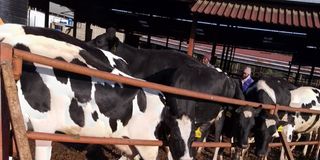Mobile app changing fortunes for Nyandarua dairy farmers

A dairy farm in Silang, Nyandarua County, where the farmer has embraced the digital livestock management system.
What you need to know:
- With the technology and subsidised AI services, milk production per cow has increased from an average of three kilos to 15 kilos, with a target of an average of 30 kilos per cow per day in three years.
Dairy farmers in Nyandarua County have embraced a modern farming technology, which many admit is a game changer.
The mobile app, introduced early this year, has come as a relief for absentee or telephone farmers, who can now get timely updates on their phones on the progress of their dairy cows.
Mr Simon Ndonga, a farmer from Wanjura Village, Ol Kalou, explains that the process starts when the dairy cattle are served Artificial Insemination (AI). A cow’s details are recorded in the Digicow mobile app, helping its owner to monitor its progress.
Timely reminder
In addition to the timely reminder about the cow's pregnancy progress, the farmer is also guided on other general management including feeding, milking, and the cow's delivery due date.
“I have been a dairy farmer for decades, but I was nearly giving up due to frustrations by employees, especially when I worked in Nairobi.
“I still had challenges when I left formal employment to engage in farming. I knew dairy farming was a rewarding venture, but I lacked timely management skills. This made me rely on commercial veterinary officers and livestock development officers for consultations, making the venture expensive. The Digicow mobile app has made it easier for me,” says Mr Ndonga.
This app gives farmers access to verified, reliable and timely information on animal husbandry from wherever they are. The App also has a real-time Chatroom where farmers get to interact, exchange ideas, and experts within the group are able to assist.
It also enables farmers to digitise their farm record and has an inbuilt analytics system that provides real time reports to the farmers. In addition, it sends notification to the farmers regarding important dates for their cows.
Mr Ndonga explains that with the app, repeat AI services are eliminated, recalling how he at one time had 10 repeat services for one cow, each time paying Sh1,500, spending Sh15,000 before the cow got pregnant.
Ms Rosemary Wamae from Ndaragua had similar challenges, explaining that the most frustrating part of dairy farming was repeat AI services.
“The cow would go on heat without us noticing. This would either mean a skipped AI service, or doing it at the wrong time. With the mobile app, everything is updated on the phone. Keeping manual records was not reliable seeing that there was always a chance of wrong entries or references.
“The app informs the farmer of every detail about livestock management, including when to stop milking to allow the cow to prepare to give birth. It also updates a farmer on what signs to look out for when monitoring the animal's health during and after pregnancy,” adds Ms Wamae.
She explains that the technology is part of a package of subsidised AI services introduced by the county government, reducing the cost of the service from Sh2,000 to Sh400 per AI service.
Ms Wamae notes that newly born calves automatically get absorbed in the system, further helping a farmer improve the breed.
Dr Edward Kanyari, the Nyandarua County Livestock Development Director in charge of the programme, explains that the county is overwhelmed by a huge farmer population embracing the subsidised AI service that comes with the technology.
“What used to happen is that most farmers had no access to the AI services while the cost was prohibitive to many others. The county government incorporated the technology to help guide the farmers on what attention to give to the dairy cattle.
“The technology also helps the department monitor the progress of dairy farming so that we can timely take mitigation measures. Apart from the app, the county has employed veterinary and livestock development officers specifically to handle this programme, which includes field visits for better analysis,” explains Dr Kanyari.
He adds that the county government is also working with cooperative societies in the 25 wards.
With the technology and subsidised AI services, milk production per cow has increased from an average of three kilos to 15 kilos, with a target of an average of 30 kilos per cow per day in three years, according to Dr Kanyari.
On repeat AI services, Dr Kanyari says it involves three players - farmer, inseminator, and the animal -
and that a repeat can be caused by the mistake of either of the three.
“Although most blame goes to the inseminator, the farmer also has a big part to play in ensuring the success of the AI services. If the farmer doesn’t feed the animal properly, of course the service will have challenges. Likewise, if the cow is of ill health, or the AI service provider does some act of omission, or the semen quality does not meet the standard. Those are the challenges we target to eliminate through this technology,” explains Dr Kanyari.
On working with cooperative societies, Governor Kiarie Badilisha explains that the national government supports one society in every ward, while the county government supports a second one, a partnership he says has accelerated the implementation of the programme and reached out to more farmers.
“We are encouraged by the increasing number of farmers embracing the subsidised AI services and the technology, but we have had a challenge with the release of funds by the National Treasury, affecting the implementation of development programmes across all sectors. This has forced us to think out of the box to ensure that we have enough supply of the semen throughout. We know that a cow cannot wait until the funds are available, that will be a wasted opportunity for the cow and the farmer,” said the governor.


